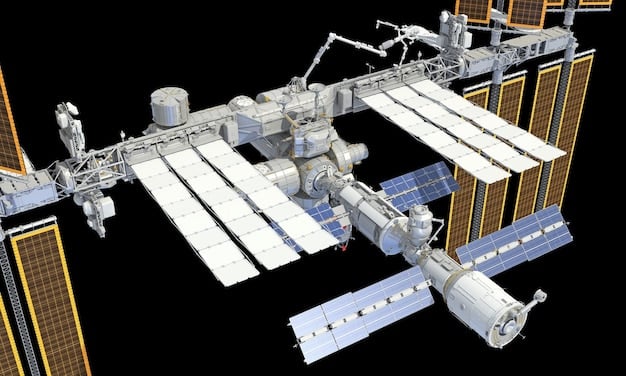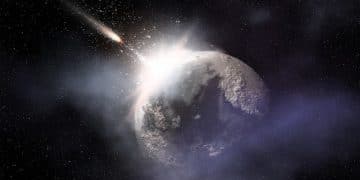Asteroid Mining for Rare Earths: Benefits and Reality Check

The potential benefits of asteroid mining for rare earth elements are immense, promising a pathway to alleviate terrestrial resource scarcity and fuel technological advancement across various industries, though its full-scale reality remains a complex challenge balancing technological readiness with economic viability and international regulation.
Delving into the cosmos, humanity stands at the precipice of an era where the vast resources of space might just unlock unprecedented growth and sustainable development back on Earth. This frontier, once confined to science fiction, is increasingly becoming a tangible prospect as the allure of celestial riches, particularly rare earth elements locked within asteroids, captures the imagination of scientists, entrepreneurs, and governments alike. But what are the potential benefits of asteroid mining for rare earth elements, and how close are we to making it a reality? This question underpins a grand vision that could redefine our industrial landscape and resource management for centuries to come.
The Lure of Rare Earth Elements (REEs) Beyond Earth
Rare earth elements (REEs) are a group of 17 chemically similar metallic elements that are critical to modern technology. Despite their name, they are not particularly rare in the Earth’s crust; however, they are rarely found in economically viable concentrations. This scarcity, coupled with complex and environmentally taxing extraction processes, has led to significant supply chain vulnerabilities globally.
The demand for REEs continues to skyrocket, driven by their indispensable role in high-tech applications. These include everything from smartphones and defense systems to renewable energy technologies like wind turbines and electric vehicles. Controlling the supply of these crucial materials grants a nation significant geopolitical leverage, making the search for alternative sources a strategic imperative.
Critical Importance in Modern Technology
The unique magnetic, luminescent, and electrochemical properties of REEs make them irreplaceable in a myriad of advanced products. For instance, neodymium and dysprosium are essential for powerful magnets in electric motors, while europium and yttrium provide the red and blue colors in LED screens. Without these elements, many of the devices we rely on daily simply wouldn’t function as effectively, if at all.
Consider the broader implications: a stable and diversified supply of REEs is not just about economic growth but also about national security and environmental sustainability. Relying on a single, dominant supplier for these critical materials introduces considerable risk, both economic and political. Therefore, exploring extraterrestrial sources represents a bold step towards achieving resource independence and fostering global stability.
- Electronics: Essential for smartphones, computers, televisions, and cameras.
- Renewable Energy: Key components in wind turbine generators and electric vehicle motors.
- Defense: Integral to guidance systems, lasers, and communication equipment.
- Medical: Used in MRI machines and medical imaging technologies.
The potential for asteroids to host vast quantities of REEs, perhaps in more accessible forms or concentrations than on Earth, fuels the ambitious concept of asteroid mining. While the path ahead is fraught with technical, economic, and ethical challenges, the potential reward of securing a stable supply of these vital elements makes the endeavor exceptionally compelling.
Asteroids as Cosmic Goldmines: Resource Composition
Asteroids are remnants from the early solar system, ranging from small rocky fragments to dwarf planets hundreds of kilometers in diameter. Their composition varies significantly, offering a rich potential for various materials, including water, precious metals, and, critically, rare earth elements. Scientists classify asteroids into several types based on their spectral properties, which hint at their internal makeup.
C-type asteroids, or carbonaceous asteroids, are the most common and are thought to contain significant amounts of water and organic compounds. M-type asteroids, on the other hand, are metallic and are believed to be rich in iron, nickel, cobalt, and potentially platinum-group metals. While all types might harbor some REEs, the specific concentrations and forms would vary, making material identification and selection crucial for successful mining operations.
Diverse Asteroid Types and Their Contents
The diverse composition of asteroids suggests that not all will be equally valuable for mining REEs. Early missions and telescopic observations are helping to catalog and characterize these space rocks, identifying prime candidates for future resource extraction. Understanding their geological history and formation processes is key to predicting where specific valuable elements might be concentrated.
For example, some asteroids are thought to be the stripped cores of early planetesimals, meaning they could contain the heavy, dense elements that settled at the center of a forming body. Others might be more akin to pristine chondrites, preserving the raw materials from the solar nebula. Each type presents a unique set of opportunities and challenges for extraction, requiring tailored approaches.
- C-Type (Carbonaceous): Rich in water, carbon compounds, and potentially some silicates.
- S-Type (Silicaceous): Composed mainly of stony materials like silicates; may also contain metals.
- M-Type (Metallic): Predominantly iron and nickel, with potential for valuable metals like platinum, gold, and possibly REEs.
The precise amount and accessibility of rare earth elements within these asteroids remain subjects of ongoing research and speculation. While theoretical models suggest the presence of these elements, confirming their economic viability requires direct exploration and detailed mapping. This foundational knowledge is paramount to transitioning from conceptual models to tangible mining plans.

Economic Imperatives: Cost vs. Reward
The economic viability of asteroid mining hinges on a delicate balance between the astronomical costs of space operations and the potential value of the extracted resources. Launching missions, developing specialized mining equipment capable of operating in harsh space environments, and establishing transportation infrastructure to bring materials back to Earth (or process them in space) demand immense capital investment.
Initially, the high entry barriers will likely mean that only the most resource-rich asteroids would be targeted, such as those with highly concentrated precious metals or water, which is valuable as propellant. However, as technologies mature and costs decline, the economic equation for rare earth elements may shift. The environmental and geopolitical costs of terrestrial mining also factor into this balance, making space resources potentially more attractive in the long run.
Scaling the Economic Ladder
The current global market for rare earth elements is dominated by a few key players, and prices can be volatile. A new, reliable source from space could stabilize markets and drive down prices, potentially disrupting traditional terrestrial mining industries. However, introducing a new supply, especially of materials currently controlled by specific nations, raises complex questions about market impact and international trade agreements.
Furthermore, the value proposition isn’t just about monetary worth. The ability to manufacture in space using extraterrestrial resources could lead to entirely new industries, such as orbital construction of large space structures, solar power satellites, or even new habitats. This “in-space economy” would reduce the need to launch materials from Earth, dramatically lowering the cost of space exploration and development. These indirect benefits significantly bolster the overall economic case for off-world mining.
- High Upfront Investment: Significant capital required for R&D, mission development, and launch infrastructure.
- Operational Costs: Sustained expenditures for life support, maintenance, and energy in space.
- Market Impact: Potential to disrupt terrestrial markets; need for controlled supply introduction.
- Return on Investment: Long-term potential for stable resource supply and new space-based industries.
Ultimately, the economic justification for asteroid mining for REEs will evolve with technological advancements and market conditions. While daunting, the prospect of unlocking vast, untapped resources could fundamentally transform economic paradigms, making it a venture worth pursuing despite its formidable challenges.
Technological Hurdles: From Concept to Capability
Making asteroid mining a reality requires overcoming formidable technological hurdles. The challenges span from identifying and reaching suitable asteroids to developing advanced robotics for extraction, processing metals in zero gravity, and safely returning materials to Earth or utilizing them in space. Each step demands unprecedented innovation and engineering prowess.
Currently, no single technology exists that can facilitate a full-scale asteroid mining operation. Instead, it will be a complex amalgamation of various cutting-edge systems working in unison. This includes sophisticated navigation and rendezvous systems for asteroids, autonomous mining robots, advanced materials science for processing, and novel propulsion methods for transport.
Key Technological Breakthroughs Required
Developing autonomous systems is paramount, as human presence in deep space mining operations would be prohibitively expensive and dangerous. These robots would need to operate with minimal human oversight, capable of self-repair and adapting to unforeseen circumstances. Furthermore, techniques for identifying and extracting specific elements at the asteroid surface or subsurface need to be perfected.
Another significant challenge lies in refining and processing materials in the vacuum of space. While some materials might be harvested directly, others will require complex chemical or metallurgical processes. This necessitates the creation of compact, efficient, and reliable processing plants that can function independently of terrestrial support, perhaps powered by solar arrays or nuclear sources.
- Precision Navigation: Ability to accurately rendezvous and station-keep with fast-moving asteroids.
- Robotic Autonomy: Development of intelligent robots capable of performing complex mining tasks with minimal human intervention.
- In-Situ Resource Utilization (ISRU): Technologies to extract and process materials directly in space, reducing reliance on Earth-launched supplies.
- Propulsion Systems: Efficient and powerful engines for transporting vast quantities of resources across vast distances.
The current state of technology indicates that while significant progress has been made in individual components, integrating them into a cohesive, operational mining system is still years, if not decades, away. Bridging this gap will require sustained investment in research and development, along with a collaborative international effort to share knowledge and resources.

Legal and Ethical Quagmires of Space Ownership
As the prospect of asteroid mining moves closer to reality, fundamental questions about ownership and regulation of space resources come into sharp focus. International space law, particularly the 1967 Outer Space Treaty, generally prohibits national appropriation of outer space, including the Moon and other celestial bodies. However, the treaty is ambiguous on whether this extends to the appropriation of resources extracted from these bodies.
This legal ambiguity creates a complex environment for companies and nations considering space mining. Without clear international consensus, the potential for disputes over resource rights, environmental impact, and fair distribution of benefits remains high. Establishing a comprehensive legal framework is critical to fostering a stable and predictable environment for future space resource utilization.
Developing a Framework for Space Law
Various proposals aim to clarify these legal ambiguities. Some argue for a “first come, first served” system, while others advocate for international oversight and a benefit-sharing mechanism similar to the Law of the Sea for ocean resources. The debate also involves whether private entities should have the right to claim resources in space, or if only nations should dictate terms.
The ethical considerations are equally complex. Should space resources be seen as a common heritage of humankind? What are the environmental implications of disturbing celestial bodies? How can the benefits of asteroid mining be distributed equitably, avoiding a scenario where only a few wealthy nations or corporations benefit? These questions highlight the need for extensive international dialogue before large-scale operations begin.
- Outer Space Treaty (1967): Prohibits national appropriation; ambiguity on resource ownership.
- Resource Claims: Debate over whether private companies or nations can claim extracted resources.
- Environmental Impact: Concerns about potential alteration or contamination of celestial bodies.
- Benefit Sharing: Discussions on equitable distribution of potential wealth and resources.
Addressing these legal and ethical challenges is as important as overcoming the technological ones. A robust and internationally recognized framework will provide the necessary stability and legitimacy for nations and private enterprises to invest confidently in asteroid mining, ensuring that the exploration and utilization of space resources proceed responsibly and sustainably.
Timelines and Prospects: How Soon is Soon?
Assessing how close we are to making asteroid mining for rare earth elements a reality involves looking at both technological readiness and economic viability, alongside the evolving legal and political landscape. While conceptually appealing, the practical implementation of asteroid mining is still a distant, yet increasingly plausible, future.
Currently, companies and space agencies are focused on precursor missions. These include asteroid sample returns, reconnaissance missions to map potential targets, and the development of key technologies such as advanced robotics and in-situ resource utilization (ISRU) for water and basic propellants. Full-scale commercial mining of REEs is likely still decades away.
Phased Approach to Asteroid Mining
The path to REE mining from asteroids is likely to be incremental. Initial efforts will probably focus on water extraction to support human missions and provide propellant for spacecraft, thereby bootstrapping an in-space economy. Following this, the mining of more common metals like iron and nickel for in-space construction could occur. Rare earth elements, given their specialized extraction and processing requirements, would likely be a later stage endeavor.
Several factors will accelerate or decelerate this timeline, including sustained government funding, private sector investment, breakthroughs in space technology, and international cooperation. A major discovery of a highly concentrated and easily accessible REE deposit on a nearby asteroid could also significantly alter the timeline, making the economic case far more compelling and immediate.
- Early Stage (Next 5-10 years): Focus on water and basic propellant ISRU, detailed asteroid reconnaissance.
- Mid Stage (10-30 years): Small-scale metal extraction for in-space manufacturing, development of orbital infrastructure.
- Long-Term (30+ years): Large-scale REE mining, return of processed materials to Earth, establishment of a robust in-space economy.
While the dream of asteroid mining for rare earth elements captivates many, the journey from concept to reality is a long and challenging one. It requires overcoming significant technological, economic, legal, and ethical hurdles. However, the potential rewards – a stable supply of critical resources and the opening of a new economic frontier – make the pursuit of this cosmic dream an endeavor of profound significance for humanity’s future.
| Key Aspect | Brief Description |
|---|---|
| 🌌 Resource Potential | Asteroids contain vast quantities of REEs, potentially alleviating Earthly scarcity and supply chain issues. |
| 💰 Economic Viability | High initial costs vs. long-term market stabilization and potential for new space industries. |
| 🚀 Technological Hurdles | Requires advanced robotics, ISRU, and efficient transportation systems, currently in development. |
| ⚖️ Legal & Ethical Debate | Unclear ownership, environmental concerns, and fair distribution of benefits demand international consensus. |
Frequently Asked Questions About Asteroid Mining
▼
Rare earth elements are crucial because of their unique magnetic, electrical, and optical properties that are indispensable for modern technologies. They are vital components in everything from high-tech electronics like smartphones and computers to critical green energy technologies such as electric vehicles and wind turbines. Their supply chain reliability is therefore a global economic and strategic concern.
▼
While various asteroid types exist, M-type (metallic) asteroids are generally considered the most promising for resource extraction due to their high concentrations of iron, nickel, cobalt, and potentially platinum-group metals. Although REEs are not typically the primary target for these, understanding their overall composition helps identify potential sources within a broader mining strategy. Detailed surveys are still required to confirm REE presence.
▼
The primary economic hurdles include the extremely high upfront capital investment required for deep space missions, the immense operational costs of working in a space environment, and uncertainties regarding the return on investment. Additionally, the existing terrestrial rare earth element market could be disrupted by new supply, necessitating careful strategic market integration to ensure profitability.
▼
No, current technology is not yet sufficient for full-scale commercial asteroid mining. While significant advancements have been made in specific areas like precision navigation and robotic autonomy, a fully integrated system for extraction, processing, and transportation of resources in space is still in the developmental phase. Major breakthroughs are needed in materials science, propulsion, and closed-loop life support systems.
▼
Realistically, large-scale commercial asteroid mining, especially for rare earth elements, is likely still several decades away. The initial phases (next 5-10 years) will focus on precursor missions and essential resource utilization like water, followed by more common metals. REEs will probably become viable targets in 30+ years, contingent on technological maturation, significant investment, and international legal frameworks.
Conclusion
The journey from contemplating asteroid mining for rare earth elements to making it a tangible reality is a colossal undertaking, one that intertwines ambitious technological development with complex economic, legal, and ethical considerations. The potential benefits are undeniable: a stable, diversified supply of elements critical to virtually every sector of modern technology, freeing us from the environmental burdens and geopolitical vulnerabilities of terrestrial mining. While the challenges are formidable, encompassing everything from advanced robotics and in-situ resource utilization to international space law and market dynamics, the strategic imperative and the long-term vision for humanity’s presence in space provide powerful motivation. As research progresses and initial exploratory missions lay the groundwork, the cosmic gold rush, once relegated to the realm of science fiction, inches closer to becoming a defining chapter in human ingenuity and resource management.





